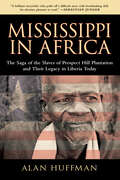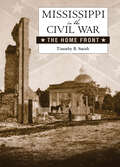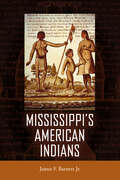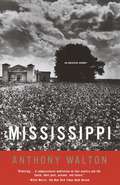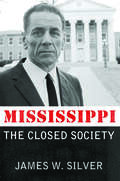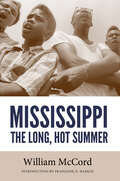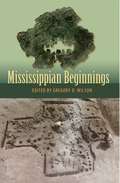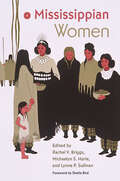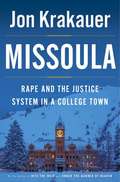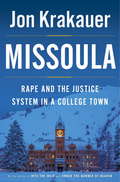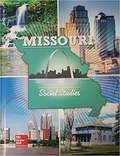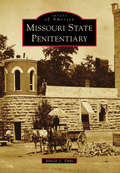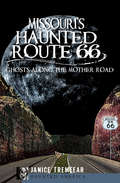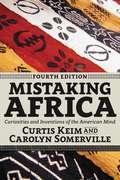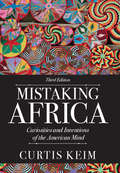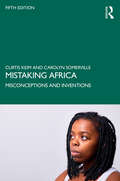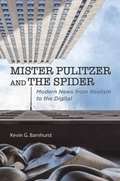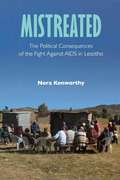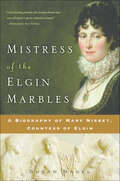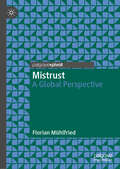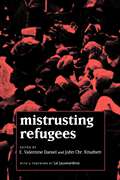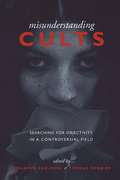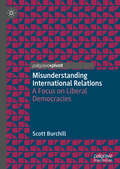- Table View
- List View
Mississippi in Africa: The Saga of the Slaves of Prospect Hill Plantation and Their Legacy in Liberia Today
by Alan HuffmanWhen wealthy Mississippi cotton planter Isaac Ross died in 1836, his will decreed that his plantation, Prospect Hill, should be liquidated and the proceeds from the sale be used to pay for his slaves' passage to the newly established colony of Liberia in western Africa. Ross's heirs contested the will for more than a decade, prompting a deadly revolt in which a group of slaves burned Ross's mansion to the ground. But the will was ultimately upheld. The slaves then emigrated to their new home, where they battled the local tribes and built vast plantations with Greek Revival-style mansions in a region the Americo-Africans renamed “Mississippi in Africa.”In the late twentieth century, the seeds of resentment sown over a century of cultural conflict between the colonists and tribal people exploded, begetting a civil war that rages in Liberia to this day. Tracking down Prospect Hill's living descendants, deciphering a history ruled by rumor, and delivering the complete chronicle in riveting prose, journalist Alan Huffman has rescued a lost chapter of American history whose aftermath is far from over.
Mississippi in the Civil War: The Home Front (Heritage of Mississippi Series)
by Timothy B. SmithIn Mississippi in the Civil War: The Home Front, Timothy B. Smith examines Mississippi's Civil War defeat by both outside and inside forces. From without, the Union army dismantled the state's political system, infrastructure, economy, and fighting capability. The state saw extensive military operations, destruction, and bloodshed within her borders. One of the most frightful and extended sieges of the war ended in a crucial Confederate defeat at Vicksburg, the capstone to a tremendous Union campaign.As Confederate forces and Mississippi became overwhelmed militarily, the populace's morale began to crumble. Realizing that the enemy could roll unchecked over the state, civilians, Smith argues, began to lose the will to continue the struggle. Many white Confederates chose to return to the Union rather than see continued destruction in the name of a victory that seemed ever more improbable. When the tide turned, Unionists and African Americans boldly stepped up their endeavors. The result, Smith finds, was a state vanquished and destined to endure suffering far into its future.The first examination of the state's Civil War home front in seventy years, this book tells the story of all classes of Mississippians during the war, focusing new light on previously neglected groups such as women and African Americans. The result is a revelation of the heart of a populace facing the devastating impact of total war.
Mississippi's American Indians (Heritage of Mississippi Series)
by James F. Barnett Jr.At the beginning of the eighteenth century, over twenty different American Indian tribal groups inhabited present-day Mississippi. Today, Mississippi is home to only one tribe, the Mississippi Band of Choctaw Indians. In Mississippi's American Indians, author James F. Barnett Jr. explores the historical forces and processes that led to this sweeping change in the diversity of the state's native peoples. The book begins with a chapter on Mississippi's approximately 12,000-year prehistory, from early hunter-gatherer societies through the powerful mound building civilizations encountered by the first European expeditions. With the coming of the Spanish, French, and English to the New World, native societies in the Mississippi region connected with the Atlantic market economy, a source for guns, blankets, and many other trade items. Europeans offered these trade materials in exchange for Indian slaves and deerskins, currencies that radically altered the relationships between tribal groups. Smallpox and other diseases followed along the trading paths. Colonial competition between the French and English helped to spark the Natchez rebellion, the Chickasaw-French wars, the Choctaw civil war, and a half-century of client warfare between the Choctaws and Chickasaws. The Treaty of Paris in 1763 forced Mississippi's pro-French tribes to move west of the Mississippi River. The Diaspora included the Tunicas, Houmas, Pascagoulas, Biloxis, and a portion of the Choctaw confederacy. In the early nineteenth century, Mississippi's remaining Choctaws and Chickasaws faced a series of treaties with the United States government that ended in destitution and removal. Despite the intense pressures of European invasion, the Mississippi tribes survived by adapting and contributing to their rapidly evolving world.
Mississippi: An American Journey (Vintage Departures)
by Anthony WaltonRaised in suburban Illinois in the 60s, a gifted student and athlete, Anthony Walton went on to Notre Dame and Brown into a career in journalism -- all the while convinced that racism, insofar as it still existed, was on the way out. Covering the racial flash points in New York in the early 80s, though, led him to feel that racism was the marrow in the American bone, and getting worse all the time. Anthony finally realized this was a demon he had to stare in the face -- which, for him, meant going "home" to Mississippi, where his parents came from and, before his birth, escaped. Still, childhood visits to relatives who stayed gave him the stuff of which nightmares are made. Yet only by learning at last his own heritage could he discover his place and his country's nature. "Mississippi -- perhaps the most loaded proper noun in American English. " What his journey covers is 200 years of history and a huge roster of famous writers, martyrs, bigots, planters and sharecroppers, bluesmen, aristocrats and plain folk, black and white together -- from those who made the history to those who inhabit it today. Neither travelogue nor lay history, neither memoir nor reportage,Mississippiis a powerful narrative that uses one place saturated in blood and lore -- what Southerners call "the South's South" -- to explore "the tragedies the past and our compulsions have visited upon us, all of us. " A book of tremendous literary and social importance.
Mississippi: The Closed Society
by James W. SilverMississippi: The Closed Society is a book about an insurrection in modern America, more particularly, about the social and historical background of that insurrection. It is written by a Mississippian who is a historian, and who, on September 30, 1962, witnessed the long night of riot that exploded on the campus of the University of Mississippi at Oxford, when students, and, later, adults with no connection with the University, attacked United States marshals sent to the campus to protect James H. Meredith, the first African American to attend Ole Miss. In the first part of Mississippi: The Closed Society, Silver describes how the state's commitment to the doctrine of white supremacy led to a situation in which the Mississippian found that continued intransigence (and possibly violence) was the only course offered to him. In these chapters the author speaks in the more formal measures of the historian. In the second part of the book, “Some Letters from the Closed Society,” he reproduces (among other correspondence and memoranda) a series of his letters to friends and family—and critics—in the days and weeks after the insurrection. Here he reveals himself more personally and forcefully. In both parts of the book are disclosed the mind and heart of the Mississippian who is as haunted as William Faulkner was by the moral chaos of his native land.
Mississippi: The Long, Hot Summer (Civil Rights in Mississippi Series)
by William McCordIn 1964, sociologist William McCord, long interested in movements for social change in the United States, began a study of Mississippi's Freedom Summer. Stanford University, where McCord taught, had been the site of recruiting efforts for student volunteers for the Freedom Summer project by such activists as Robert Moses and Allard Lowenstein. Described by his wife as “an old-fashioned liberal,” McCord believed that he should both examine and participate in events in Mississippi. He accompanied student workers and black Mississippians to courthouses and Freedom Houses, and he attracted police attention as he studied the mechanisms of white supremacy and the black nonviolent campaign against racial segregation. Published in 1965 by W. W. Norton, his book, Mississippi: The Long, Hot Summer, is one of the first examinations of the events of 1964 by a scholar. It provides a compelling, detailed account of Mississippi people and places, including the thousands of student workers who found in the state both opportunities and severe challenges. McCord's work sought to communicate to a broad audience the depth of repression in Mississippi. Here was evidence of the need for federal action to address what he recognized as both national and southern failures to secure civil rights for black Americans. His field work and activism in Mississippi offered a perspective that few other academics or other white Americans had shared. Historian Françoise N. Hamlin provides a substantial introduction that sets McCord's work within the context of other narratives of Freedom Summer and explores McCord's broader career that combined distinguished scholarship with social activism.
Mississippian Beginnings (Florida Museum of Natural History: Ripley P. Bullen Series)
by Gregory D. WilsonUsing fresh evidence and nontraditional ideas, the contributing authors of Mississippian Beginnings reconsider the origins of the Mississippian culture of the North American Midwest and Southeast (A.D. 1000–1600). Challenging the decades-old opinion that this culture evolved similarly across isolated Woodland popu¬lations, they discuss signs of migrations, missionization, pilgrimages, violent conflicts, long-distance exchange, and other far-flung entanglements that now appear to have shaped the early Mississippian past. Presenting recent fieldwork from a wide array of sites including Cahokia and the American Bottom, archival studies, and new investigations of legacy collections, the contributors interpret results through contemporary perspectives that emphasize agency and historical contingency. They track the various ways disparate cultures across a sizeable swath of the continent experienced Mississippianization and came to share simi¬lar architecture, pottery, subsistence strategies, sociopolitical organization, iconography, and religion. Together, these essays provide the most comprehensive examination of early Mississippian culture in over thirty years. A volume in the Florida Museum of Natural History: Ripley P. Bullen Series
Mississippian Women (Florida Museum of Natural History: Ripley P. Bullen Series)
by Lynne P. Sullivan Rachel V. Briggs Michaelyn S. HarleHighlighting the role of precontact Indigenous women in building and transforming Mississippian culture This volume highlights how women were powerful farmers, economic decision-makers, spiritual leaders, and agents of social integration in the diverse societies of the Mississippian world, which spanned the present-day United States South to the Midwest before the seventeenth century. While Mississippian societies are some of the most well-researched pre-European contact societies on the continent, little attention has been dedicated specifically to Mississippian women. These chapters offer new insights into the vital role women played within their communities, an approach directly informed by the powerful position of American Indian women within contemporary American Indian communities. Contributors examine themes such as identity, labor, grieving, cooking, craft production, spatial organization, prestige, morbidity, kinship, and fertility. Case studies include sites throughout the Mississippian world, ranging from Illinois to Florida, including Cahokia and Moundville. Mississippian Women is the first volume to focus solely on the political, social, and economic power of women during this period, linking their actions in building their culture before European colonialism with the work of Indigenous women in the region today. A volume in the Florida Museum of Natural History: Ripley P. Bullen Series
Missoula: Rape and the Justice System in a College Town
by Jon KrakauerFrom bestselling author Jon Krakauer, a stark, powerful, meticulously reported narrative about a series of sexual assaults at the University of Montana -- stories that illuminate the human drama behind the national plague of campus rape. Missoula, Montana, is a typical college town, with a highly regarded state university, bucolic surroundings, a lively social scene, and an excellent football team -- the Grizzlies -- with a rabid fan base. The Department of Justice investigated 350 sexual assaults reported to the Missoula police between January 2008 and May 2012. Few of these assaults were properly handled by either the university or local authorities. In this, Missoula is also typical. A DOJ report released in December of 2014 estimates 110,000 women between the ages of eighteen and twenty-four are raped each year. Krakauer's devastating narrative of what happened in Missoula makes clear why rape is so prevalent on American campuses, and why rape victims are so reluctant to report assault. Acquaintance rape is a crime like no other. Unlike burglary or embezzlement or any other felony, the victim often comes under more suspicion than the alleged perpetrator. This is especially true if the victim is sexually active; if she had been drinking prior to the assault -- and if the man she accuses plays on a popular sports team. The vanishingly small but highly publicized incidents of false accusations are often used to dismiss her claims in the press. If the case goes to trial, the woman's entire personal life becomes fair game for defense attorneys. This brutal reality goes a long way towards explaining why acquaintance rape is the most underreported crime in America. In addition to physical trauma, its victims often suffer devastating psychological damage that leads to feelings of shame, emotional paralysis and stigmatization. PTSD rates for rape victims are estimated to be 50%, higher than soldiers returning from war. In Missoula, Krakauer chronicles the searing experiences of several women in Missoula -- the nights when they were raped; their fear and self-doubt in the aftermath; the way they were treated by the police, prosecutors, defense attorneys; the public vilification and private anguish; their bravery in pushing forward and what it cost them. Some of them went to the police. Some declined to go to the police, or to press charges, but sought redress from the university, which has its own, non-criminal judicial process when a student is accused of rape. In two cases the police agreed to press charges and the district attorney agreed to prosecute. One case led to a conviction; one to an acquittal. Those women courageous enough to press charges or to speak publicly about their experiences were attacked in the media, on Grizzly football fan sites, and/or to their faces. The university expelled three of the accused rapists, but one was reinstated by state officials in a secret proceeding. One district attorney testified for an alleged rapist at his university hearing. She later left the prosecutor's office and successfully defended the Grizzlies' star quarterback in his rape trial. The horror of being raped, in each woman's case, was magnified by the mechanics of the justice system and the reaction of the community. Krakauer's dispassionate, carefully documented account of what these women endured cuts through the abstract ideological debate about campus rape. College-age women are not raped because they are promiscuous, or drunk, or send mixed signals, or feel guilty about casual sex, or seek attention. They are the victims of a terrible crime and deserving of compassion from society and fairness from a justice system that is clearly broken.
Missoula: Rape and the Justice System in a College Town
by Jon KrakauerFrom bestselling author Jon Krakauer, a stark, powerful, meticulously reported narrative about a series of sexual assaults at the University of Montana — stories that illuminate the human drama behind the national plague of campus rape Missoula, Montana, is a typical college town, with a highly regarded state university, bucolic surroundings, a lively social scene, and an excellent football team — the Grizzlies — with a rabid fan base. The Department of Justice investigated 350 sexual assaults reported to the Missoula police between January 2008 and May 2012. Few of these assaults were properly handled by either the university or local authorities. In this, Missoula is also typical. A DOJ report released in December of 2014 estimates 110,000 women between the ages of eighteen and twenty-four are raped each year. Krakauer&’s devastating narrative of what happened in Missoula makes clear why rape is so prevalent on American campuses, and why rape victims are so reluctant to report assault. Acquaintance rape is a crime like no other. Unlike burglary or embezzlement or any other felony, the victim often comes under more suspicion than the alleged perpetrator. This is especially true if the victim is sexually active; if she had been drinking prior to the assault — and if the man she accuses plays on a popular sports team. The vanishingly small but highly publicized incidents of false accusations are often used to dismiss her claims in the press. If the case goes to trial, the woman&’s entire personal life becomes fair game for defense attorneys. This brutal reality goes a long way towards explaining why acquaintance rape is the most underreported crime in America. In addition to physical trauma, its victims often suffer devastating psychological damage that leads to feelings of shame, emotional paralysis and stigmatization. PTSD rates for rape victims are estimated to be 50%, higher than soldiers returning from war. In Missoula, Krakauer chronicles the searing experiences of several women in Missoula — the nights when they were raped; their fear and self-doubt in the aftermath; the way they were treated by the police, prosecutors, defense attorneys; the public vilification and private anguish; their bravery in pushing forward and what it cost them. Some of them went to the police. Some declined to go to the police, or to press charges, but sought redress from the university, which has its own, non-criminal judicial process when a student is accused of rape. In two cases the police agreed to press charges and the district attorney agreed to prosecute. One case led to a conviction; one to an acquittal. Those women courageous enough to press charges or to speak publicly about their experiences were attacked in the media, on Grizzly football fan sites, and/or to their faces. The university expelled three of the accused rapists, but one was reinstated by state officials in a secret proceeding. One district attorney testified for an alleged rapist at his university hearing. She later left the prosecutor&’s office and successfully defended the Grizzlies&’ star quarterback in his rape trial. The horror of being raped, in each woman&’s case, was magnified by the mechanics of the justice system and the reaction of the community. Krakauer&’s dispassionate, carefully documented account of what these women endured cuts through the abstract ideological debate about campus rape. College-age women are not raped because they are promiscuous, or drunk, or send mixed signals, or feel guilty about casual sex, or seek attention. They are the victims of a terrible crime and deserving of compassion from society and fairness from a justice system that is clearly broken.
Missouri Social Studies
by Authors of McGraw-Hill EducationThis book is organized to help the students understand and apply social studies content and skills as they read. The Big Ideas in this book are important ideas in social studies. They help understand each unit and its Missouri Grade-Level Expectations, or Standards.
Missouri State Penitentiary
by Arnold G. ParksThe Missouri State Penitentiary was established in 1833 via a bill passed by the state legislature, and the first prisoner was incarcerated in 1835. Inmates constructed the main prison building from rock quarried at the site in 1836. The penitentiary closed on September 15, 2004, and plans are in place to redevelop the site into offices for state agencies and private enterprises. The Missouri State Penitentiary was once considered one of the largest maximum-security penal institutions in the United States. After 550 serious assaults occurred inside the prison in the early 1960s, Time magazine called it "the bloodiest 47 acres in America" (although the walls of the penitentiary only contained 37 acres). The penitentiary had the distinction of housing some very famous individuals: boxing champion Sonny Liston learned to box there under the direction of the prison chaplain, infamous gangster Charles Arthur "Pretty Boy" Floyd spent time there, and James Earl Ray was an escapee when he shot and killed Dr. Martin Luther King Jr.
Missouri's Haunted Route 66: Ghosts Along the Mother Road (Haunted America)
by Janice TremeearRide shotgun with the author of Haunted Ozarks on this scary road trip across Missouri&’s stretch of the &“Main Street of America.&” Alongside the nostalgic appeal of Route 66 lurk ghostly roadside hitchhikers, the Goatman of Rolla, amusement park spirits, the Civil War–dead, and the shadows thrown by the mighty Thunderbird. Spanning three hundred dangerously curving miles, the stretch of the Mother Road in Missouri earned the title of &“Bloody 66,&” and some of its stopping places are marked by equally grim history. The Lemp Mansion saw family members commit suicide one by one. Springfield&’s Pythian Castle was an orphanage before becoming a military hospital and housing World War II prisoners of war. Follow Janice Tremeear as she takes a detour down Zombie Road, peers into the matter of the Joplin Spook Light and even stays overnight in Missouri&’s most haunted locations to discover what makes the Show Me State such a lively place for the dead.
Missouri: A Geography
by Milton RaffertyMissouri-from the gateway arch in St. Louis to the Pony Express stables in St. Joseph, from the Ozarks of the south to the rolling, corn-studded hills of the north-is the subject of this comprehensive geography. Dr. Rafferty brings together a wealth of information about Missouri's resources and people, tracing the theme of persistence versus change
Mistaking Africa: Curiosities and Inventions of the American Mind
by Curtis A. Keim Carolyn SomervilleFor many Americans the mention of Africa immediately conjures up images of safaris, ferocious animals, strangely dressed "tribesmen," and impenetrable jungles. Although the occasional newspaper headline mentions authoritarian rule, corruption, genocide, devastating illnesses, or civil war in Africa, the collective American consciousness still carries strong mental images of Africa that are reflected in advertising, movies, amusement parks, cartoons, and many other corners of society. Few think to question these perceptions or how they came to be so deeply lodged in American minds. Mistaking Africa looks at the historical evolution of this mind-set and examines the role that popular media plays in its creation. The authors address the most prevalent myths and preconceptions and demonstrate how these prevent a true understanding of the enormously diverse peoples and cultures of Africa. Updated throughout, the fourth edition covers the entire continent (North and sub-Saharan Africa) and provides new analysis of topics such as social media and the Internet, the Ebola crisis, celebrity aid, and the Arab Spring. Mistaking Africa is an important book for African studies courses and for anyone interested in unraveling American misperceptions about the continent.
Mistaking Africa: Curiosities and Inventions of the American Mind
by Curtis A KeimFor many Americans the mention of Africa immediately conjures up images of safaris, ferocious animals, strangely dressed "tribesmen," and impenetrable jungles. Although the occasional newspaper headline mentions genocide, AIDS, malaria, or civil war in Africa, the collective American consciousness still carries strong mental images of Africa that are reflected in advertising, movies, amusement parks, cartoons, and many other corners of society. Few think to question these perceptions or how they came to be so deeply lodged in American minds. Curtis Keim's Mistaking Africa looks at the historical evolution of this mind-set and examines the role that popular media plays in its creation. Keim addresses the most prevalent myths and preconceptions and demonstrates how these prevent a true understanding of the enormously diverse peoples and cultures of Africa. Updated throughout, the third edition includes a new chapter, "Where Is the Real Africa," discussing the multifaceted nature of the question and the importance of not grasping onto stereotypes of Africa's mythical past. Keim also includes new examples and new images to expand the visual narrative of western views about Africa. Mistaking Africa is an important book for African studies courses and for anyone interested in unraveling American misperceptions about the continent.
Mistaking Africa: Misconceptions and Inventions
by Curtis Keim Carolyn SomervilleFor many in the west, the mention of Africa immediately conjures up images of safaris, ferocious animals, sparsely dressed "tribesmen," and impenetrable jungles. Newspaper headlines rarely touch on Africa, but when they do, they often mention authoritarian rule, corruption, genocide, devastating illnesses, or civil war. Advertising, movies, amusement parks, cartoons, and many other corners of society all convey strong mental images of the continent that together form a collective consciousness. Few think to question these perceptions or how they came to be so deeply lodged in western minds.Mistaking Africa looks at the historical evolution of this mind-set and examines the role that popular media plays in its creation. The authors address the most prevalent myths and preconceptions and demonstrate how these prevent a true understanding of the enormously diverse peoples and cultures of Africa. Updated throughout, the fifth edition considers images of Africa from across the world and provides new analysis of what Africans are doing themselves to rewrite the stories of their continent, particularly through social and digital media.Mistaking Africa is an important book for African studies courses and for anyone interested in unraveling misperceptions about the continent.
Mister Pulitzer and the Spider: Modern News from Realism to the Digital
by Kevin G BarnhurstA spidery network of mobile online media has supposedly changed people, places, time, and their meanings. A prime case is the news. Digital webs seem to have trapped "legacy media," killing off newspapers and journalists' jobs. Did news businesses and careers fall prey to the digital "Spider"? To solve the mystery, Kevin Barnhurst spent thirty years studying news going back to the realism of the 1800s. The usual suspects--technology, business competition, and the pursuit of scoops--are only partly to blame for the fate of news. The main culprit is modernism from the "Mister Pulitzer" era, which transformed news into an ideology called "journalism." News is no longer what audiences or experts imagine. Stories have grown much longer over the past century and now include fewer events, locations, and human beings. Background and context rule instead. News producers adopted modernism to explain the world without recognizing how modernist ideas influence the knowledge they produce. When webs of networked connectivity sparked a resurgence in realist stories, legacy news stuck to big-picture analysis that can alienate audience members accustomed to digital briefs.
Mistreated: The Political Consequences of the Fight against AIDS in Lesotho
by Nora KenworthyAs global health institutions and aid donors expanded HIV treatment throughout Africa, they rapidly "scaled up" programs, projects, and organizations meant to address HIV and AIDS. Yet these efforts did not simply have biological effects: in addition to extending lives and preventing further infections, treatment scale-up initiated remarkable political and social shifts.In Lesotho, which has the world's second highest HIV prevalence, HIV treatment has had unintentional but pervasive political costs, distancing citizens from the government, fostering distrust of health programs, and disrupting the social contract. Based on ethnographic observation between 2008 and 2014, this book chillingly anticipates the political violence and instability that swept through Lesotho in 2014.This book is a recipient of the Norman L. and Roselea J. Goldberg Prize from Vanderbilt University Press for the best book in the area of medicine.
Mistress of the Elgin Marbles: A Biography of Mary Nisbet, Countess of Elgin
by Susan Nagel“A lively and welcome account of a charismatic woman,” drawing on the personal correspondence of Lady Mary Bruce, wife of the Earl of Elgin (People).The remarkable Mary Nisbet was the Countess of Elgin in Romantic-era Scotland and the wife of the seventh Earl of Elgin. When Mary accompanied her husband to diplomatic duty in Turkey, she changed history. She helped bring the smallpox vaccine to the Middle East, struck a seemingly impossible deal with Napoleon, and arranged the removal of famous marbles from the Parthenon. But all of her accomplishments would be overshadowed, however, by her scandalous divorce. Drawing from Mary’s own letters, scholar Susan Nagel tells Mary’s enthralling, inspiring, and suspenseful story in vibrant detail.“Absorbing . . . required reading for anyone interested in cultural history, as well as the art of biography.” —Booklist“A sympathetic and emotionally charged portrait . . . [written] with insight and compassion yet without sentimentality.” —Publishers Weekly“A unique life related with animation, admiration, and affection.” —Kirkus Reviews
Mistrust: A Global Perspective
by Florian MühlfriedThis book examines the social practice of mistrust through the lens of social anthropology. In focusing on the citizens of the Caucasus, a region located at the crossroads of Europe and Asia, Mühlfried counters the postcolonial discourse that routinely treats these individuals, known for their mistrust of the state, as “others.” Combining ethnographic observations presenting mistrust as an observable reality with socio-political issues from a non-Western region, Mühlfried opens up a non-Eurocentric perspective on an underexplored social practice and a major counterpoint to the well-examined social phenomenon of “trust.” This perspective allows for a more profound understanding of pressing issues such as populist movements and post-truth politics.
Mistrusting Refugees
by E. Valentine Daniel John Chr. KnudsenThe twentieth century has seen people displaced on an unprecedented scale and has brought concerns about refugees into sharp focus. There are forty million refugees in the world—1 in 130 inhabitants of this planet. In this first interdisciplinary study of the issue, fifteen scholars from diverse fields focus on the worldwide disruption of "trust" as a sentiment, a concept, and an experience.Contributors provide a rich array of essays that maintain a delicate balance between providing specific details of the refugee experience and exploring corresponding theories of trust and mistrust. Their subjects range widely across the globe, and include Palestinians, Cambodians, Tamils, and Mayan Indians of Guatemala. By examining what individuals experience when removed from their own culture, these essays reflect on individual identity and culture as a whole.
Misunderstanding Cults: Searching for Objectivity in a Controversial Field (The Royal Society of Canada Special Publications)
by Benjamin Zablocki Thomas RobbinsMisunderstanding Cults provides a uniquely balanced contribution to what has become a highly polarized area of study. Working towards a moderate "third path" in the heated debate over new religious movements or cults, this collection includes contributions from both scholars who have been characterized as "anticult" and those characterized as "cult-apologists." The study incorporates multiple viewpoints as well as a variety of theoretical and methodological perspectives, with the stated goal of depolarizing the discussion over alternative religious movements. A prominent section within the book focuses explicitly on the issue of scholarly objectivity and the danger of partisanship in the study of cults. The collection also includes contributions on the controversial and much misunderstood topic of brainwashing, as well as discussions of cult violence, children brought up in unconventional religious movements, and the conflicts between alternative religious movements and their critics. Unique in its breadth, this is the first study of new religious movements to address the main points of controversy within the field while attempting to find a middle ground between opposing camps of scholarship.
Misunderstanding International Relations: A Focus on Liberal Democracies
by Scott BurchillThis book examines the ways in which the study and practice of international relations are misunderstood, both by scholars and politicians. It begins by examining critical errors in reasoning and argument which determine the way key issues in the field are discussed and explained. It then explores a number of case studies which are affected by these errors, including the legal status of the modern nation-state, the Israel-Palestine conflict, the idea of the Deep State, the relationship between the West and radical Islam, the impact of moral righteousness on historical understanding, and the role of class in modern Western politics.
